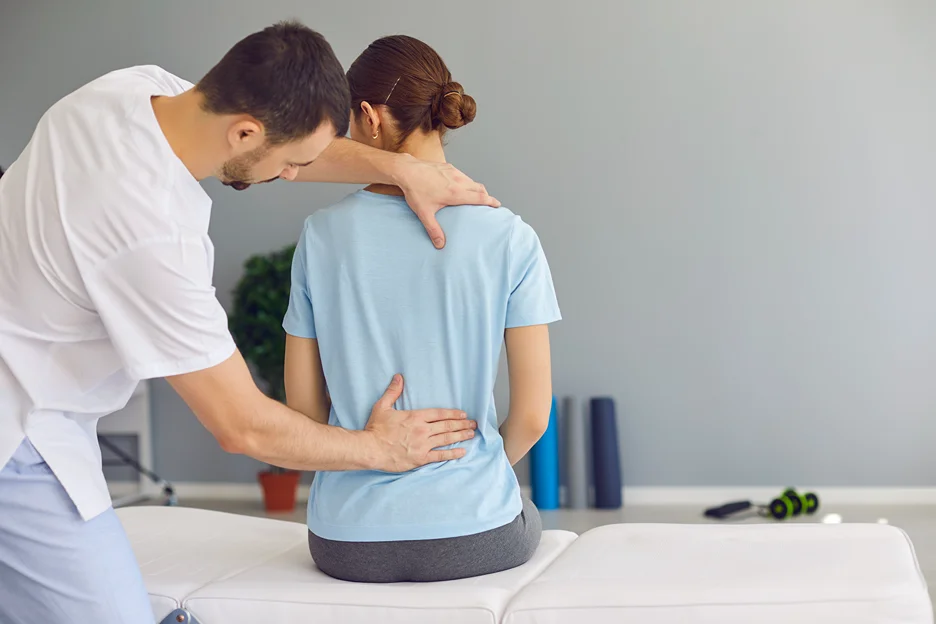If you’re one of the millions who suffer from lower back pain that seems to flare up whenever you sit down, you know how frustrating and limiting this can be.
At Kaly, we understand how chronic back pain can seriously impact your quality of life. That’s why we’ve put together this helpful guide on managing and preventing lower back pain specifically associated with sitting.
We know that sitting for long periods can compress the discs and strain muscles in your lower back. And if you have underlying conditions like a herniated disc or spinal stenosis, sitting can further aggravate your symptoms.
The good news is there are many things you can do, from adjusting your posture to doing simple stretches, that can provide relief. Read on for our top tips to sit pain-free.
Proper Posture is Key

Maintaining proper posture is crucial for avoiding lower back pain when seated. Be sure to:
- Keep your ears, shoulders, and hips aligned vertically. Avoid slouching or hunching over.
- Support your lower back with a small pillow or rolled-up towel.
- Sit with your knees level with your hips. Your feet should be flat on the floor.
- Avoid crossing your legs, which can rotate your pelvis and strain your back.
- Use a supportive, ergonomic chair that allows you to sit with proper posture.
Take Regular Breaks
Sitting for long stretches can cause back muscles to stiffen and spasm. Get up and move around for a few minutes at least once an hour. Gentle walking and stretching will get blood flowing and loosen up your back.
Try Simple Stretches
Certain seated stretches can provide quick relief for lower back pain:
- Knee-to-chest – Hug one knee at a time to your chest. Hold for 30 seconds.
- Seated twist – Gently rotate your upper body side to side. Repeat 5-10 times per side.
- Cat-cow – Inhale as you arch your back, exhale as you round your spine. Repeat 5-10 times.
- Child’s pose – Sit back on your feet, lowering your chest between your knees.
Exercise Your Core
Having strong abdominal and back muscles supports your lower spine and can prevent pain. Try bridges, planks, and other core exercises. Check with your doctor before starting any new workout routine.
Watch Your Posture When Standing
How you transition from sitting to standing is also important. Roll your shoulders back and engage your core before slowly rising. Avoid hunching or bending at the waist.
Improve Ergonomics
Make sure your workstation is set up properly to avoid strain on your back. Your screen should be at eye level and your wrists in a neutral position when typing.
When to Seek Help

If you have severe, worsening, or persistent lower back pain, consult your doctor. They can assess if there is an underlying condition causing your symptoms. Physical therapy, medication, or back braces may help relieve discomfort.
FAQ about Lower Back Pain When Sitting
What are the main causes of lower back pain when sitting?
Sitting puts strain on the discs, muscles, and ligaments in your lower back. Underlying conditions like herniated discs, arthritis, and spinal stenosis can also contribute to pain.
What’s the best sitting position to alleviate lower back pain?
Keep your back straight and supported against your chair. Your knees should be at hip level with feet flat to align your hips and spine.
How can I maintain good sitting posture to avoid lower back pain?
Keep your ears, shoulders, and hips vertically aligned. Use a back support. Avoid slouching or twisting. Take regular breaks to move and stretch.
Are there specific exercises to alleviate pain in the bottom of my back when sitting?
Yes, try gentle stretches like knee-to-chest, cat-cow pose, and seated twists. Core strengtheners like planks can also help.
Why does my back hurt only when sitting but not standing?
Sitting puts more pressure on your spine versus standing. Weak core muscles or poor posture when seated may also play a role.
Why does my sacrum hurt when sitting?
Your sacrum helps transfer your body weight when seated. Strain, posture issues, or sacroiliac joint dysfunction can cause sacral pain.
What stretches can I do while sitting to help lower back pain?
Try knee-to-chest pulls, seated twists, and cat-cow poses. Lumbar rolls by bracing your hands behind you and arching your back can also help.
Can sitting too long cause pain in my lower back and testicles?
Yes, prolonged sitting can compress nerves that run through your lower back down to your testicles. Take regular breaks when sitting.
How can I alleviate lower back pain when standing up from sitting?
Roll your shoulders back and engage your core muscles before slowly rising. Avoid bending forward at the waist.
Why do I experience lower back pain when sitting at my desk?
Bad posture, lack of lumbar support, and poor desk ergonomics can strain your back over time. Adjust your setup and sit with proper posture.
At Kaly, we want to make life pain-free for you. Try our tips above to sit without hurting. And let us know if you have any other questions – we’re here to help you conquer lower back pain!
